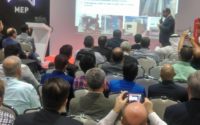Auditors Must Think Differently To Overcome Innovation Barriers
Internal auditors should overcome innovation barriers by thinking outside the box and by redefining the concept of innovation per se, the UAE’s internal audit community has been told at the members meeting of the UAE Internal Auditors Association (UAE IAA) in Abu Dhabi.
“Modern day management warrants innovation in a new perspective as innovations thrive on resolving contradictions. They should think differently how to create compelling customer value, and how to flow that value through streamlined processes by embedding a real discipline around pursuit of perfection,” said Abdulqader Obaid Ali, Chairman of UAE Internal Auditors Association (UAE IAA).
Making a presentation titled ‘Overcoming Innovation Barriers’ at the monthly members meeting of the UAE IAA, Ninad Pradhan, Senior Consultant & Trainer, UAE IAA, said that many organisations face project constraints, psychological inertia, limited breadth of knowledge, and are unable to forecast the future and therefore solve the wrong problem.
UAE IAA, a non-profit organisation of internal auditor sunder the Ministry of Community Development, was set up in 1995 along the lines of its parent body, the Institute of Internal Auditors (IIA) with 190,000 members from more than 170 countries and territories. The UAE accounts for about 45% of the total number of internal auditors working in the region, estimated at about 7,000 auditors, of which 22% are Emirati citizens.
Debunking the generally perceived notion that innovation is only about new gadgetry, Ninad said that it’s about satisfaction and value, the way of doing things better than it was done earlier and endorsed management guru Peter Ducker’s view that it’s a term of economics rather than technology.
He put forward the idea of TRIZ, the Theory of Inventive Problem Solving, devised by a Soviet engineer who worked as a clerk in the patent office and embarked on finding some generic rules that would explain creation of new, inventive ideas.
An ideal TRIZ roadmap identifies components of the system by component analysis, identifies and evaluates the functions performed by the components through function modelling and functional analysis, and then identifies interaction between the components through interaction analysis.
Innovative solutions resolve contradictions and not settle for a compromise or trade-off. Contradictions can occur when improving one characteristics lead to deterioration of another, he said.
“Interaction analysis identifies all the interactions between the components whether it is positive, negative or neutral. Function modelling is a stage which describes the functions, their usefulness and performance level, i.e. an action performed by one component on another,” he added.







